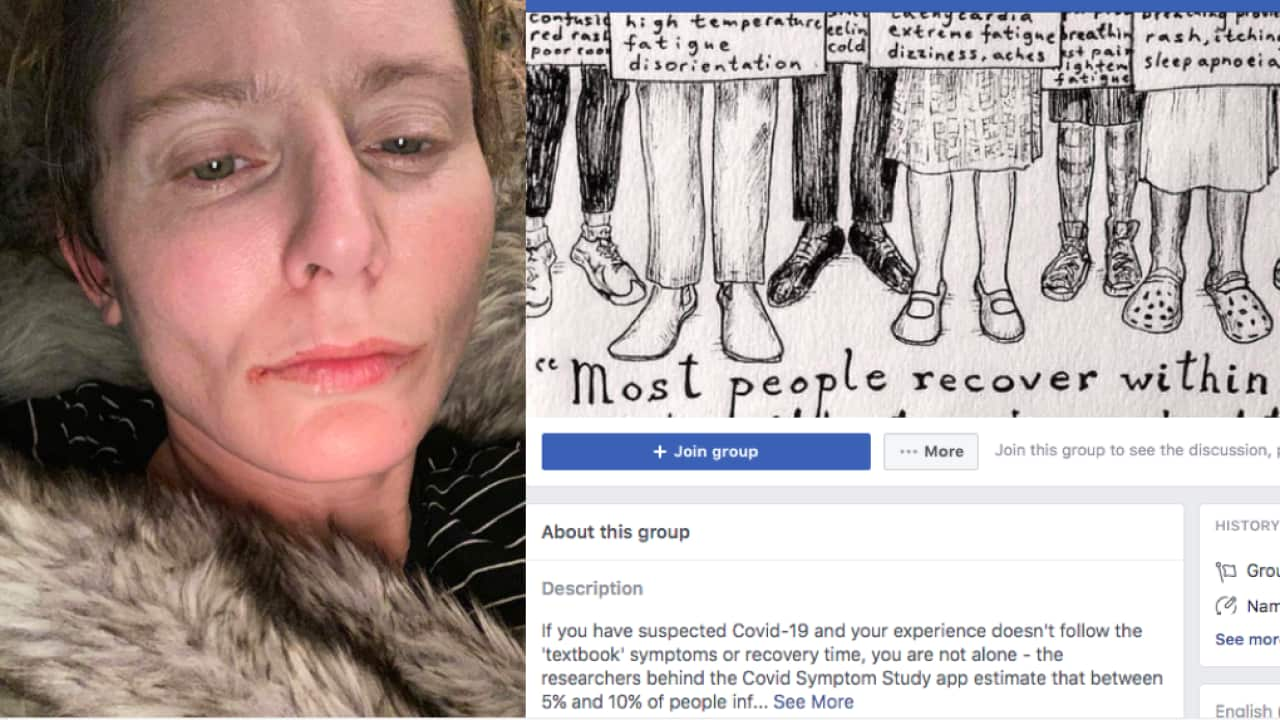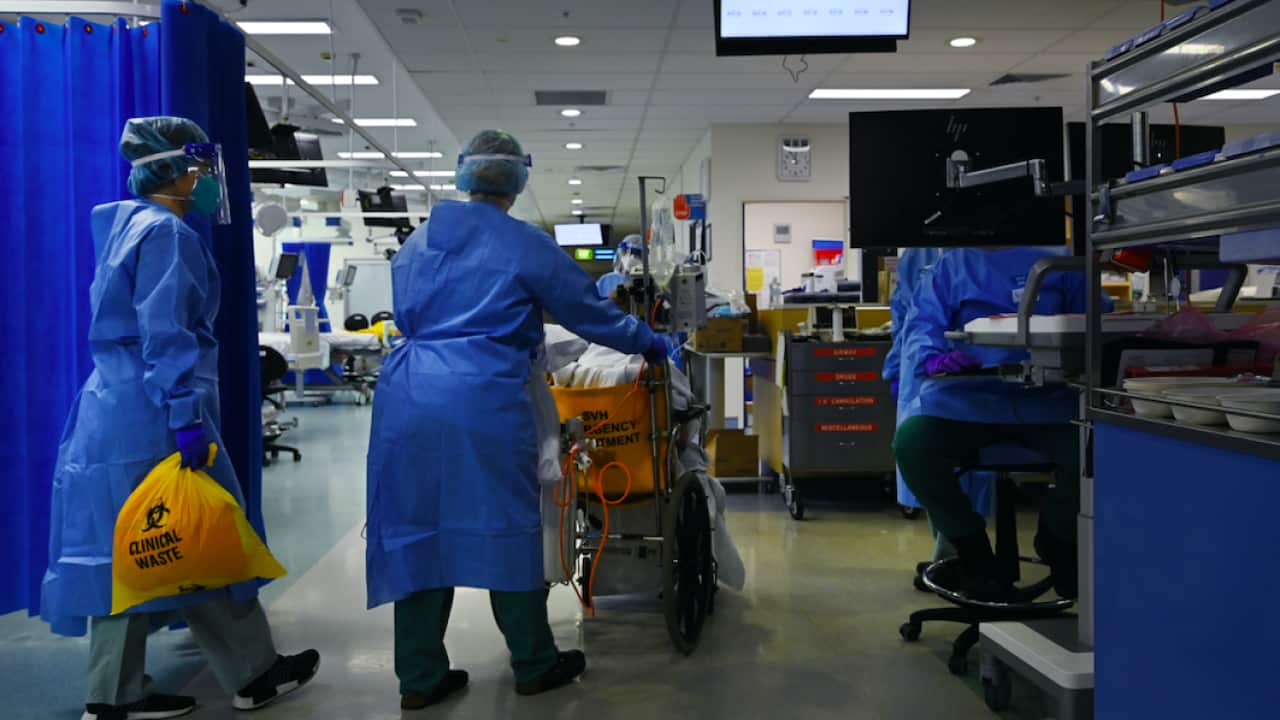

10 min read
This article is more than 3 years old
'From Wonder Woman to nothing': The reality of having long COVID
While many Australians hope 2022 will bring a return to their pre-pandemic lives, for those with persistent COVID-19 symptoms, there’s no end in sight. Unable to return to work and unsure of what financial support they'll qualify for in the future, they don't know how they'll cope.
Published 31 December 2021 5:29pm
Updated 23 February 2022 3:47am
By Evan Young
Source: SBS News
Image: Annie Morrow first tested positive to COVID-19 in July 2020. (Supplied/Annie Morrow)
In the space of 18 months, Annie Morrow has “gone from Wonder Woman to nothing”.
“I can’t do anything for myself anymore,” the 56-year-old says.
Annie contracted COVID-19 while working at an aged care facility in Melbourne in July 2020 during Victoria’s fatal second wave of the virus.
“I walked into a resident’s room to help him and I was unaware that he had COVID. I helped him for about 15 minutes and two days later, he tested positive for COVID. Four days later, I tested positive.”
The same day she tested positive, the man she caught the virus from died.
“That was really difficult for me,” she says.

Annie Morrow still has COVID-19 symptoms a year and a half after first testing positive Source: Supplied/Annie Morrow
She's one of the hundreds, possibly thousands, of people in Australia with long COVID, a term coined to describe symptoms existing well past an initial diagnosis of COVID-19 and which can't be explained by other causes.
“I’ve got brain fog, muscle pain, body aches and ridiculous fatigue. I just want to sleep all the time, and when I do hop into bed, I can’t sleep.
“I've got limb numbness. My throat and voice are always croaky. I've got a lot of mucus, and intermittent taste and smell. I have not had a menstrual cycle since all of this started and I've got my really long curly hair falling out.
“And I'm on antidepressants because the pain and the loss that I've experienced is just absolutely overwhelming.”
‘We're dipping into our savings’
Experiencing debilitating symptoms and emotional distress, Annie resigned from her job.
She'd been working 76 hours a fortnight and walking up to 18 kilometres a day, she says.
She also moved herself and her family to South Australia.
Initially, she was receiving worker's compensation, but the payment has now decreased to around $700 a week and there’s no guarantee it will continue beyond the new year.
On top of that, she has an ever-expanding list of specialist appointments, tests, and medications to pay for. This Christmas she struggled to afford presents for her grandchildren, she says.
“We're dipping into our savings. My husband doesn't earn enough on one wage to be able to get a mortgage. So I really feel like I'm letting us down as a couple.
“We've never been in this situation before.”

Judy Li tested positive to COVID-19 in the first half of 2020 Source: Supplied/Judy Li
She initially thought her symptoms were related to a switch in her medication, but 18 months on, they remain.
She says she's now being "handballed from doctor to doctor" and can no longer continue in her job as an IT project manager or care for her two children in the same way she could before.
"I'm scared," she says.
Judy's husband has also been forced to take months of leave from his job without pay to look after her and their children, putting strain on their finances. They were on track to buying a house before the diagnosis.
"We were saving for a deposit. We know that we're not going to get approval for a mortgage now because our incomes dropped so much," Judy says.
"Sometimes I think my family would be better off without me because I feel like I'm a burden. Like, it would be easier if I wasn't around."
How is long COVID defined?
Stuart Tan is a Sydney physician specialising in trauma and rehabilitation. He's among the Australian researchers currently attempting to understand the long-term impacts of COVID-19.
“Long COVID is difficult to diagnose because it's not a clear-cut disease entity like COVID itself, and it's also difficult because it's a novel infection,” he says.
“We're learning more and more each day. It’s still an ongoing acquisition of knowledge around the condition.”
The Department of Health defines long COVID as being "where symptoms of COVID-19 remain, or develop, long after the initial infection – usually after four weeks. Symptoms of long COVID can last for weeks or sometimes months, and include:
- extreme fatigue (tiredness)
- shortness of breath, heart palpitations, chest pain or tightness
- problems with memory and concentration
- changes to taste and smell
- joint and muscle pain."
On 3 December, Health Minister Greg Hunt acknowledged the impacts of long COVID in a press conference.
"We do know that long COVID is sadly a reality for many people, whether it is respiratory impacts, whether it is impacts in relation to their neurological acuity and their capacity, or whether it is in relation to their ability to function with full energy," he said.
He announced $48 million of new COVID research funding, of which $3.3 million will go to Murdoch University in Perth to focus on the impact of long COVID.
But while the research matters, Annie says she would like to see the government give people in Australia with persistent debilitating COVID-19 symptoms given greater access to financial support in the meantime.
“I feel like I'm being punished because I went to work and did the best job I could to keep everybody safe - and now I'm struggling financially to keep a roof over my head.”
“So that would be a really good step for them to have a look at that.”
What support is available?
Those who cannot work due to a disability or long-term medical condition can apply to access the National Disability Insurance Scheme (NDIS) or Disability Support Pension (DSP).
But to access the NDIS, you must be able to prove you have a lifelong condition that significantly reduces your capacity to live "an ordinary life", and gather a raft of supporting medical documents which in itself can be very costly.
When it comes to the DSP - a payment for which - your condition must also be “fully diagnosed, treated and stabilised”.
Given the lack of thorough understanding around long COVID and its subsequent difficulty to diagnose, both support avenues are essentially off the table for Annie, Judy, and others like them.

Judy Li at the beach before contracting COVID-19. Source: Supplied/Judy Li
“It is also important that the Disability Support Pension is made available to people with chronic ill health who are unable to engage in paid work ... and eligibility criteria are regularly reviewed to reflect contemporary medical evidence, including in relation to the effects of long COVID,” she says.
Asked what financial support is currently available for people with lingering COVID-19 symptoms, a spokesperson for the Department of Social Services said: “The Australian government’s number one priority is supporting Australians into appropriate and stable work, but we understand that some people cannot work due to illness or injury”.
They said Australians who are temporarily unable to work because of illness or injury may be able to access the JobSeeker payment - which is about $620 a fortnight (or $44 a day) and be exempt from .
“They may also be eligible for a health care card, which may provide access to cheaper medicines under the Pharmaceutical Benefits Scheme, bulk-billed doctor visits (at the discretion of the provider) and bigger refunds for medical costs when they reach the relevant Medicare safety net threshold,” the spokesperson said.
State and territory governments, local governments, and private providers can also support people with the costs of living and health care, they added.
Judy was recently approved for JobSeeker and has some savings to help get her through the immediate future, but she's worried it won't be enough in the long term.
"I can't work. I can't look after my children. I can't go on like this. I need some help - and it's really hard to see a specialist because no one knows enough about long COVID," she says.
"I would like the government to give more active assistance to people and for there to be fewer hoops to jump through."
‘We need to be looked after’
Dr Tan was the principal investigator of a long COVID study published in late 2021 that surveyed people who tested positive to initial variants of the virus.
It found 73 per cent of participants had lingering symptoms four and a half months after diagnosis. Nearly half (47 per cent) of all participants reported hair loss, blurry vision and brain fog, while 45 per cent were unable to perform pre-COVID activities.
Dr Tan says researchers are looking now to recruit people who contracted the Delta variant.
Another recent survey by Monash University found more than 70 per cent of patients who were treated in ICU for COVID-19 had lingering health issues six months on.
Both studies are consistent with findings reported from overseas.
Dr Tan says “it would not be surprising” if the number of people experiencing long COVID continued to grow in the future.
“Recovering from COVID-19 is a long journey and it is important that the needs of these individuals are not forgotten in the longer term.”
Judy says while she is "immensely worried" about her future, there are likely to be others with lasting COVID-19 symptoms with an even smaller safety net.
"I'm really lucky that we do have some things ... but I really feel for people who don't have any savings."
Annie, meanwhile, is unsure if she’ll ever work again and says those with lingering COVID-19 symptoms are being left behind as Australia deals with another surge in cases.
“Frontline workers, we need to be looked after. It's not like I did a stupid thing and walked into my workplace and picked up something inappropriately," she says.
“I contracted COVID through looking after and loving somebody and caring for them - and now he's not here anymore, and I have to live with what I have to live with.
“I just hope the government or somebody can give us some answers”.
31 December 2021 marks two years since the first case of what turned out to be COVID-19 was officially reported to the World Health Organization.
People who are unwell are advised to contact the Healthdirect 24-hour health advice helpline on 1800 022 222 or their doctor. In an emergency call 000.
Readers seeking crisis support can contact Lifeline on 13 11 14, the Suicide Call Back Service on 1300 659 467 and Kids Helpline on 1800 55 1800 (for young people aged up to 25). More information and support with mental health is available at Beyond Blue.org.au and on 1300 22 4636.
Embrace Multicultural Mental Health supports people from culturally and linguistically diverse backgrounds.
If you would like to share your story with SBS News, email [email protected]


